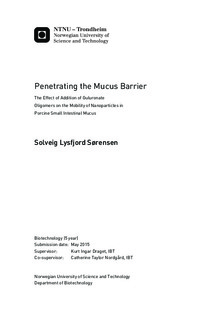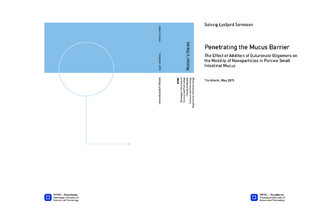| dc.description.abstract | Oral delivery is the easiest and most used method of drug delivery. However, the gastrointestinal (GI) tract poses many hurdles for the drugs to overcome before they can reach their target. One of them is the viscous, adhesive, and constantly replenishing mucus layer. Mucus layer effectively hinders particles and microorganisms from passing through by several mechanisms: the steric, interactive, and dynamic barriers. Nanoparticle drug delivery systems can be modified to affect the solubility, stability, permeability or other properties of biopharmaceuticals, leading to improved bioavailability and an enhanced, controlled or more rapid therapeutic effect. Modification of nanoparticles in order to penetrate the mucus layer more efficiently is an attractive prospect to increase the efficacy of the drug. PEGylation is a technique for enhancing particle transport and mobility in mucus. Low molecular weight G-blocks have been shown to transiently weaken the mucus layer, possibly allowing for more rapid diffusion of substances.
In addition, biosimilar mucus is a proposed model for porcine small intestinal mucus (PSIM). Caco-2 cells, a common cell line used in drug absorption studies, are not compatible with native mucus. Biosimilar mucus could be an attractive alternative. It is necessary to assess the diffusion of large particles in biosimilar mucus in comparison with porcine small intestinal mucus, to evaluate the viability of the model.
In this study, the effect of PEGylation on nanoparticle mobility in PSIM and biosimilar mucus is examined. The effects of added G-blocks on the mobility of various types of nanoparticles in both PSIM and biosimilar mucus are studied. General nanoparticle mobility in biosimilar mucus and PSIM is compared. Nanoparticle mobility was measured using multiple particle tracking (MPT).
There was no consistent effect of adding G-blocks to increase particle mobility in porcine small intestinal mucus. This is in conflict with earlier reports. A possible explanation could be changes in mucus structure caused by repeated thawing and freezing. Biosimilar mucus, as it is today, was found to not be a suitable model for the transport of large entities like nanoparticles in porcine small intestinal mucus, because of the large differences in particle mobility observed between the two types of mucus. However, changes in the composition of biosimilar mucus could possibly produce a more viable model. | |

